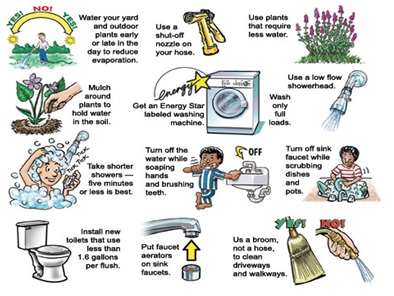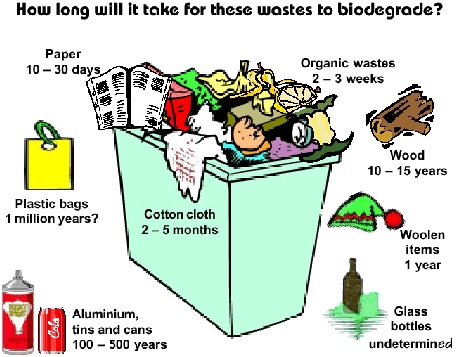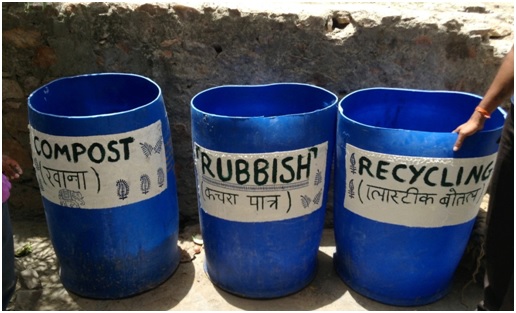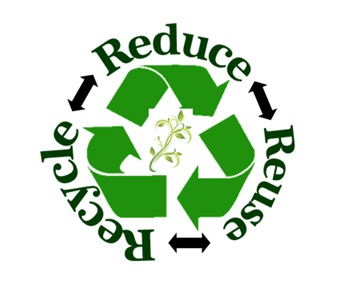Go Green
3 R’s of environmental protection: Reduce, Reuse, Recycle
REDUCE
YOUR CONSUMPTION
The first step to reducing your impact on the environment, is reducing the amounts of resources you consume and use. Think twice before you buy or use anything. Do you really need it? By reducing your consumption you will also decrease the amount of waste you produce.
YOUR WASTE
There are also many other ways to reduce your waste. The opportunities are nearly endless. Here are just a few ideas.
- Think before you print or photocopy! Print and copy as little as possible.
- Edit on screen, not on paper.
- Use e-mail to minimize paper use.
- Send and store documents like necessary papers and business proposals electronically instead of on paper.
- When you must print or copy, do it double-sided.
- Circulate documents instead of making an individual copy for everyone.
- Change the margins on your Word documents. The default margins on the documents you print are 1.25 inches on all sides. Simply changing the margins to 0.75 inches will reduce the amount of paper you use by almost 5 percent.
- Start a compost bin. Some people set aside a place in their yard where they can dispose of certain food and plant materials. Over time, the materials will break down through a natural process called decomposition. The compost is good for the soil in your yard and means that less garbage will go to the landfill.
- Instead of buying something you’re not going to use very often, see if you can borrow it from someone you know.
YOUR ENERGY CONSUMPTION
There are so many ways of optimizing your energy consumption
- Turn off unused or unneeded lights.
- Use natural lighting instead of electric lighting whenever possible.
- If you have a desk lamp, make sure it uses fluorescent bulbs (instead of incandescent bulbs).
- Dress appropriate to the season
- Select cold water for washing clothes
- Keep windows and doors closed in heated and air-conditioned areas.
- Turn off computers when they are not in use.
- Turn off printers, especially laser printers, unless printing.
- Don’t use power strips to turn on all computers and desk equipment at once.
- When purchasing computers and peripherals, buy low wattage equipment
- Minimize use of screen savers and instead enable power management features
- Purchase only energy-efficient products
Move your refrigerator. Leaving space between your refrigerator and the wall increases air circulation around the condenser coils, allowing the fridge to operate more efficiently.
YOUR OIL CONSUMPTION AND POLLUTION
Drive Efficiently – If you must drive, buck the trend toward more wasteful vehicles and drive a fuel efficient car, i.e. one which gets more miles per gallon, and don’t drive it more than you really need to! Park your car in the shade. Gas evaporates from your fuel tank more quickly when you park in the sun. Parking in the shade lowers the temperature in your gas tank by up to 7 degrees, significantly reducing fuel evaporation.

REUSE
Plastic containers can become food storage, paper can become wrapping paper. The ways in which to reuse things are unlimited. All you need is to be creative. If being creative is not your thing, here are some other ideas:
- Reuse envelopes by placing a new label over the old address.
- Designate a box for scrap paper and use it for printing all drafts or unofficial documents.
- Reuse plastic bags or better get a reusable canvas bags.
- Bring cloth sacks to the store with you instead of taking home new paper or plastic bags. You can use these sacks again and again. You’ll be saving some trees.
- Plastic containers and reusable lunch bags are great ways to take your lunch to school without creating waste.
- Coffee cans, shoe boxes, margarine containers, and other types of containers people throw away can be used to store things or can become fun arts and crafts projects. Use your imagination.
- Don’t throw out clothes, toys, furniture, and other things that you don’t want anymore. Somebody else can probably use them. Give them to a charity or give them to friends, or even you can sell them online using online resale sites.
- Use all writing paper on both sides.
- Use paper grocery bags to make book covers rather than buying new ones.
- Use silverware and dishes instead of disposable plastic utensils and plates.
- Store food in reusable plastic containers.
RECYCLE
- When buying any type of product, see if it is available with post consumer recycled content.
- Wrap presents in gift bags. Once you tear the wrapping paper off a holiday gift it ends up in the recycle bin, but gift bags can be used over and over again.
- Production of recycled paper uses only half the water and 3/4 of the energy than new paper
- Every ton of recycled paper saves almost 400 gallons of oil, three cubic yards of landfill space and seventeen trees.
- If you recycle soda cans, the energy used and air pollution created, is 95 percent less than if the cans were produced from raw materials.
- You could operate a TV set for an estimated three hours with the energy saved by recycling just one aluminum can
- Thinking green means being aware of our interconnectedness with the world and reflecting on the unintended damage we cause nature in the daily course of our lives. Thinking green leads to acting green – taking corrective action to make environmental responsibility a reality.
- In addition to recycling the things you buy, you can help the environment by buying products that contain recycled materials. Many brands of paper towels, garbage bags, greeting cards, and toilet paper, to name a few examples, will tell you on their labels if they are made from recycled materials.
- In India in many cities and towns you can leave your recyclables in bins outside your home, and a truck will come and collect them regularly
- Whatever your system is, it’s important to remember to rinse out and sort your recyclables!



Eat Green:
The choices we make about what we eat each day really can have some major environmental consequences. It’s easy to forget about the energy, water, chemicals and effort used to produce everyday food items like chocolate bars, soft drink or a packet of chips. Not to mention the fuel burnt getting these items to you.
How to reduce this impact on Mother earth?
- Eat lower on the food chain – Meat production can be energy, resource and pollution intensive.
- Eating a diet rich in fruits, vegetables, grains and legumes is healthier and easier on the planet. Consider exploring vegetarian options.
- Eat locally – it saves transportation costs and helps the local economy, too.
- Take only as much as you can eat.
- Avoid throwaway plates, cups, flatware and trays. Carry and use your reusable mug.
- and use reusable bags which is old style but is good for mother earth.
- Eat at food service areas where you can use ceramic plates and cups, metal silverware and reusable trays.
- Avoid take-out food which is over-packaged and uses thermocol materials degradation of which takes several years in soil.
Buy Green:
Consumers need to become more aware of the indirect impacts their purchases have. After food, clothing purchases alone have the second highest environmental impact (in terms of land disturbance, energy and water use) of all our consumption activities. The amount of water used in the production and transport of clothes bought by an average household each year is 150,000 litres.
Buying CDs, head phones, phone covers, plastic wraps, booklets, packaging… all these add more burden on earth as production of these items requires significant amount of resources. Next time you go shopping ask yourself a few questions before making a purchase. For example, how far has this product travelled to reach the shelf? Which country or place it is originated? How long will this product last? Is there a better alternative, or do I even need it at all?
To reduce the impact of your shopping on the mother earth go green in following ways.
Avoid buying new appliances: A substantial amount of household energy consumption and greenhouse pollution can be attributed to white goods (fridges, freezers, washing machines, televisions and clothes dryers). If you don’t really need a new appliance and you only want the latest model because it looks good and your friend has one, don’t buy it. If you really do need a new appliance, compare the energy rating of different models (and buy the most efficient one), buy the most durable one, and only operate it to the manufacturer’s instructions.
Only buy things that last for long: There is no point buying a cheap air conditioner or TV that you know will not last for long. Look for, and only purchase items that are water and/or energy efficient. Items that are built to last may be more expensive up-front but they’ll be much cheaper in the long run. This applies to big purchases (like cars), and equally to smaller purchases (like light bulbs, for example).
Look for energy saving stars: All new appliances are required to show their energy or water efficiency under a star rating system. More stars equal greater product efficiency. Some products like TVs and stereos may comply with energy standards without a label displayed. Ask sales staff and check in brochures for information on how a product compares to the energy star standard. If sales staff can’t tell you, get them to ask their supplier. And if you can’t get any information, don’t buy the product.
Buy the most energy or water efficient option: Make sure you purchase the most energy or water efficient item that meets your needs. Consider alternatives. For example, laptop computers are more efficient than desktops. Front-loading washing machines use significantly less water than top-loaders. And refrigerators with built in icemakers are a waste of energy.
REFERENCES:
1) http://www.factmonster.com/
2) http://www.go-green.ae/greensites.php
4) http://www.businessinsider.com/electronics-recycling-photos-2013-3
5) http://timesofindia.indiatimes.com/topic/waste-recycling-plant


